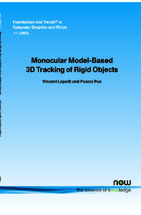Monocular Model-Based 3D Tracking of Rigid Objects: A Survey
By Vincent Lepetit, Computer Vision Laboratory, Switzerland, Vincent.Lepetit@epfl.ch | Pascal Fua, Computer Vision Laboratory, Switzerland, Pascal.Fua@epfl.ch
Abstract
Many applications require tracking of complex 3D objects. These include visual servoing of robotic arms on specific target objects, Augmented Reality systems that require real-time registration of the object to be augmented, and head tracking systems that sophisticated interfaces can use. Computer Vision offers solutions that are cheap, practical and non-invasive.
This survey reviews the different techniques and approaches that have been developed by industry and research. First, important mathematical tools are introduced: Camera representation, robust estimation and uncertainty estimation. Then a comprehensive study is given of the numerous approaches developed by the Augmented Reality and Robotics communities, beginning with those that are based on point or planar fiducial marks and moving on to those that avoid the need to engineer the environment by relying on natural features such as edges, texture or interest. Recent advances that avoid manual initialization and failures due to fast motion are also presented. The survery concludes with the different possible choices that should be made when implementing a 3D tracking system and a discussion of the future of vision-based 3D tracking.
Because it encompasses many computer vision techniques from lowlevel vision to 3D geometry and includes a comprehensive study of the massive literature on the subject, this survey should be the handbook of the student, the researcher, or the engineer who wants to implement a 3D tracking system.
Monocular Model-Based 3D Tracking of Rigid Objects
Many applications require tracking complex 3D objects. These include visual serving of robotic arms on specific target objects, Augmented Reality systems that require real time registration of the object to be augmented, and head tracking systems that sophisticated interfaces can use. Computer Vision offers solutions that are cheap, practical and non-invasive.
Monocular Model-Based 3D Tracking of Rigid Objects reviews the different techniques and approaches that have been developed by industry and research. First, important mathematical tools are introduced: Camera representation, robust estimation and uncertainty estimation. Then a comprehensive study of the numerous approaches developed by the Augmented Reality and Robotics communities is given. The authors begin with those that are based on 1D or planar fiducial marks and move on to those that avoid the need to engineer the environment by relying on natural features such as edges, texture or interest points are detailed. Extensions to more specific applications that require the use of a motion model or multiple objects tracking are also discussed. The survey concludes with the different possible choices that should be made when implementing a 3D tracking system and a discussion of the future of vision-based 3D tracking.
Because it encompasses many computer vision techniques from low-level vision to 3D geometry and includes a comprehensive study of the massive literature on the subject, Monocular Model-Based 3D Tracking of Rigid Objects is an invaluable reference for the student and researcher.
